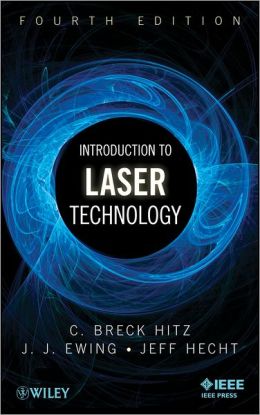 [内容简介]
[内容简介]
The only introductory text on the market today that explains the underlying physics and engineering applicable to all lasers
Although lasers are becoming increasingly important in our high-tech environment, many of the technicians and engineers who install, operate, and maintain them have had little, if any, formal training in the field of electro-optics. This can result in less efficient usage of these important tools.
Introduction to Laser Technology, Fourth Edition provides readers with a good understanding of what a laser is and what it can and cannot do. The book explains what types of laser to use for different purposes and how a laser can be modified to improve its performance in a given application. With a unique combination of clarity and technical depth, the book explains the characteristics and important applications of commercial lasers worldwide and discusses light and optics, the fundamental elements of lasers, and laser modification.?
In addition to new chapter-end problems, the Fourth Edition includes new and expanded chapter material on:
- Material and wavelength
- Diode Laser Arrays
- Quantum-cascade lasers
- Fiber lasers
- Thin-disk and slab lasers
- Ultrafast fiber lasers
- Raman lasers
- Quasi-phase matching
- Optically pumped semiconductor lasers
Introduction to Laser Technology, Fourth Edition is an excellent book for students, technicians, engineers, and other professionals seeking a fuller, more formal introduction to the field of laser technology.
[目录]
Preface ix
Acknowledgments xi
Chapter 1 An Overview of Laser Technology 1
1.1 What are Lasers Used For? 2
1.2 Lasers in Telecommunications 3
1.3 Lasers in Research and Medicine 4
1.4 Lasers in Graphics and Grocery Stores 4
1.5 Lasers in the Military 5
1.6 Other Laser Applications 5
Chapter 2 The Nature of Light 7
2.1 Electromagnetic Waves 7
2.2 Wave-Particle Duality 10
Chapter 3 Refractive Index, Polarization, and Brightness 17
3.1 Light Propagation—Refractive Index 17
3.2 Huygens' Principle 21
3.3 Polarization 24
3.4 Polarization Components 27
3.5 Birefringence 30
3.6 Brewster's Angle 36
3.7 Brightness 41
Chapter 4 Interference 43
4.1 What is Optical Interference? 43
4.2 Everyday Examples of Optical Interference 45
4.3 Young's Double-Slit Experiment 46
4.4 Fabry-Perot Interferometer 49
Chapter 5 Laser Light 55
5.1 Monochromaticity 55
5.2 Directionality 56
5.3 Coherence 60
Chapter 6 Atoms, Molecules, and Energy Levels 63
6.1 Atomic Energy Levels 63
6.2 Spontaneous Emission and Stimulated Emission 65
6.3 Molecular Energy Levels 66
6.4 Some Subtle Refinements 64
Chapter 7 Energy Distributions and Laser Action 73
7.1 Boltzmann Distribution 73
7.2 Population Inversion 76
7.3 L.A.S.E.R. 79
7.4 Three-Level and Four-Level Lasers 82
7.5 Pumping Mechanisms 83
Chapter 8 Laser Resonators 87
8.1 Why a Resonator? 87
8.2 Circulating Power 88
8.3 Gain and Loss 90
8.4 Another Perspective on Saturation 91
8.5 Relaxation Oscillations 93
8.6 Oscillator-Amplifiers 94
8.7 Unstable Resonators 95
8.8 Laser Mirrors 95
Chapter 9 Resonator Modes 99
9.1 Spatial Energy Distributions 99
9.2 Transverse Resonator Modes 100
9.3 Gaussian-Beam Propagation 101
9.4 A Stability Criterion 107
9.5 Longitudinal Modes 109
Chapter 10 Reducing Laser Bandwidth 113
10.1 Measuring Laser Bandwidth 113
10.2 Laser-Broadening Mechanisms 116
10.3 Reducing Laser Bandwidth 118
10.4 Single-Mode Lasers 122
Chapter 11 Q-S witching 129
11.1 Measuring the Output of Pulsed Lasers 129
11.2 Q-Switching 135
11.3 Types of Q-S witches 135
11.4 Mechanical Q-Switches 135
11.5 A-0 Q-Switches 136
11.6 E-O Q-Switches 138
11.7 Dye Q-Switches 140
Chapter 12 Cavity Dumping and Modelocking 143
12.1 Cavity Dumping 143
12.2 Partial Cavity Dumping 147
12.3 Modelocking—Time Domain 147
12.4 Modelocking—Frequency Domain 151
12.5 Applications of Modelocked Lasers 152
12.6 Types of Modelocked Lasers 153
Chapter 13 Nonlinear Optics 155
13.1 What is Nonlinear Optics? 155
13.2 Second-Harmonic Generation 158
13.3 Birefringent Phase Matching 161
13.4 Quasi-Phasematching 165
13.5 Intracavity Harmonic Generation 168
13.6 Higher Harmonics 169
13.7 Optical Parametric Oscillation 170
13.8 Raman lasers 172
Chapter 14 Semiconductor Lasers 175
14.1 Semiconductor Physics 175
14.2 Modern Diode Lasers 181
14.3 Diode Laser Bandwidth 182
14.4 Wavelength of Diode Lasers 183
14.5 Diode Arrays and Stacks 185
14.6 Vertical Cavity, Surface-Emitting Lasers 185
14.7 Optically Pumped Semiconductor Lasers 187
14.8 Quantum Cascade Lasers 189
Chapter 15 Solid-State Lasers 191
15.1 Solid-State Laser Materials 191
15.2 Diode-Pumped Solid State Lasers 195
15.2.1 Diode-Pumping Geometry 199
15.2.2 Pump Diodes, Pulsing, and Packaging 199
15.3 Lamp Pumping 201
15.4 Thermal Issues in Solid-State Lasers 205
15.5 Scaling Diode-Pumped Lasers to High Power 207
Chapter 16 Fiber Lasers 215
16.1 Acceptance Angle and Numerical Aperture 215
16.2 Doping Optical Fibers 216
16.3 Pumping Fiber Lasers 217
16.4 Fabricating Optical Fibers 218
16.5 Feedback for Fiber Lasers 219
16.6 High Power Fiber Lasers 220
16.7 Large-Mode-Area Fibers 221
16.8 Holey Fibers 222
Chapter 17 Gas lasers: Helium-Neon and Ion 225
17.1 Gas-Laser Transitions 226
17.2 Gas-Laser Media and Tubes 227
17.3 Laser Excitation 229
17.4 Optical Characteristics 230
17.5 Wavelengths and Spectral Width 230
17.6 He-Ne Lasers 232
17.7 Principles of He-Ne Lasers 232
17.8 Structure of He-Ne Lasers 234
17.9 Ar-and Kr-Ion Lasers 235
Chapter 18 Carbon Dioxide and Other Vibrational Lasers 239
18.1 Vibrational Transitions 240
18.2 Excitation 242
18.3 Types of CO2 Lasers 243
18.4 Optics for CO2 Lasers 246
18.5 Chemical Lasers 246
Chapter 19 Excimer Lasers 249
19.1 Excimer Molecules 251
19.2 Electrical Considerations 253
19.3 Handling the Gases 255
19.4 Applications of Excimer Lasers 259
Chapter 20 Tunable and Ultrafast Lasers 263
20.1 Dye Lasers 265
20.2 Tunable Solid-State Lasers 268
20.3 Nonlinear Converters 271
20.4 Ultrafast Lasers 274
Glossary 283
Further Reading 291
Index 293

 新书报道
新书报道